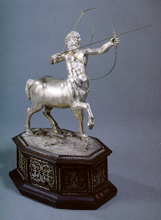
39.3 x 16 x 25
Silver, brass and ebony
INDEX 1788 : F.III.159
Automaton, quod Centauri figuram argenteam profert. Dum movetur sagitam ejaculatur.
Automaton that represents the figure of a silver centaur. When it moves an arrow is cast.
This piece is composed of a silver centaur equipped with a mechanism that shoots arrows. This centaur is on an octagonal black wooden box, with silver decorations on every surface. On the top, insects and lizards can be seen in relief. The centaur holds a flexible steel bow in his extended left arm. The right arm is bent in the position of one who is about to shoot an arrow. He has a cross-wise waist belt and an arrow-case where two arrows can be found.
Inside of the box there is a cord mechanism activated by means of a key, incomplete, that used to make the arm of the centaur move by a transmission system that follows through the interior of his left front leg. In the mechanism installed inside of the wooden box, three wheels used to exist, that the assemblage would sit on when placed on the floor. One of the wheels would have been in a position slightly below the left leg of the centaur. Under the right leg the absence of another wheel, which would have been identical to the first, can be noted. On the back part of the box there used to be a third wheel, smaller than the front ones, articulated around a vertical axle. This location of the wheels allowed the centaur to change position owing to the articulation of the back wheel.
According to Rómulo de Carvalho in his book entitled História do Gabinete de Física da Universidade de Coimbra, the centaur possessed the following inscription: "GEORGIUS ADAMS, Apud Insigm. Capite Thychonis Braheii in Vico Vulgo Dicto Fleet Street. LONDINI FECIT". Now, the above inscription does not appear on the box, which suggests that it must have had a lid that would have covered the bottom of the box, in order to protect the internal mechanism. Actually, a group of orifices on the periphery of the box can be found, where the screws that would have fixed the lid to the box would have been. It was probably removed to do some repairs to the mechanism and not replaced.
This centaur is not part of the list of instruments from Colégio dos Nobres but was acquired by dalla Bella to be integrated into the mechanics instruments used to study the simple and complex machines.
Carvalho, Rómulo de, História do Gabinete de Física da Universidade de Coimbra, Universidade de Coimbra, Biblioteca Geral, Coimbra, 1978, pp. 101 and 304-305.